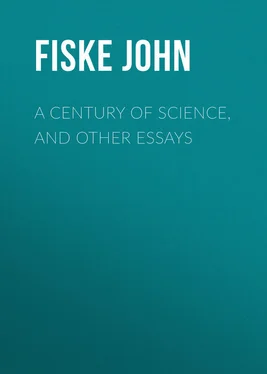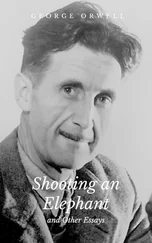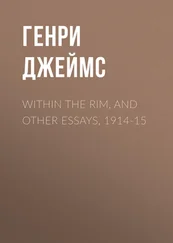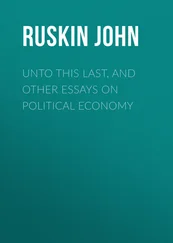John Fiske - A Century of Science, and Other Essays
Здесь есть возможность читать онлайн «John Fiske - A Century of Science, and Other Essays» — ознакомительный отрывок электронной книги совершенно бесплатно, а после прочтения отрывка купить полную версию. В некоторых случаях можно слушать аудио, скачать через торрент в формате fb2 и присутствует краткое содержание. Жанр: foreign_antique, foreign_prose, на английском языке. Описание произведения, (предисловие) а так же отзывы посетителей доступны на портале библиотеки ЛибКат.
- Название:A Century of Science, and Other Essays
- Автор:
- Жанр:
- Год:неизвестен
- ISBN:нет данных
- Рейтинг книги:3 / 5. Голосов: 1
-
Избранное:Добавить в избранное
- Отзывы:
-
Ваша оценка:
- 60
- 1
- 2
- 3
- 4
- 5
A Century of Science, and Other Essays: краткое содержание, описание и аннотация
Предлагаем к чтению аннотацию, описание, краткое содержание или предисловие (зависит от того, что написал сам автор книги «A Century of Science, and Other Essays»). Если вы не нашли необходимую информацию о книге — напишите в комментариях, мы постараемся отыскать её.
A Century of Science, and Other Essays — читать онлайн ознакомительный отрывок
Ниже представлен текст книги, разбитый по страницам. Система сохранения места последней прочитанной страницы, позволяет с удобством читать онлайн бесплатно книгу «A Century of Science, and Other Essays», без необходимости каждый раз заново искать на чём Вы остановились. Поставьте закладку, и сможете в любой момент перейти на страницу, на которой закончили чтение.
Интервал:
Закладка:
Returning to that chemistry with which we started, we may recall two laws that were propounded early in the century, one of which was instantly adopted, while the other had to wait for its day. Dalton's law of definite and multiple proportions has been ever since 1808 the corner stone of chemical science, and the atomic theory by which he sought to explain the law has exercised a profound influence upon all modern speculation. The other law, announced by Avogadro in 1811, that, "under the same conditions of pressure and temperature, equal volumes of all gaseous substances, whether elementary or compound, contain the same number of molecules," was neglected for nearly fifty years, and then, when it was taken up and applied, it remodelled the whole science of chemistry, and threw a flood of light upon the internal constitution of matter. In this direction a new world of speculation is opening up before us, full of wondrous charm. The amazing progress made since Priestley's day may be summed up in a single contrast. In 1781 Cavendish ascertained the bare fact that water is made up of oxygen and hydrogen; within ninety years from that time Sir William Thomson was able to tell us that "if the drop of water were magnified to the size of the earth, the constituent atoms would be larger than peas, but not so large as billiard balls." Such a statement is confessedly provisional, but, allowing for this, the contrast is no less striking.
Concerning the various and complicated applications of physical science to the arts, by which human life has been so profoundly affected in the present century, a mere catalogue of them would tax our attention to little purpose. As my object in the present sketch is simply to trace the broad outlines of advance in pure science, I pass over these applications, merely observing that the perpetual interaction between theory and practice is such that each new invention is liable to modify the science in which it originated, either by encountering fresh questions or by suggesting new methods, or in both these ways. The work of men like Pasteur and Koch cannot fail to influence biological theory as much as medical practice. The practical uses of electricity are introducing new features into the whole subject of molecular physics, and in this region, I suspect, we are to look for some of the most striking disclosures of the immediate future.
A word must be said of the historical sciences, which have witnessed as great changes as any others, mainly through the introduction of the comparative method of inquiry. The first two great triumphs of the comparative method were achieved contemporaneously in two fields of inquiry very remote from one another: the one was the work of Cuvier, above mentioned; the other was the founding of the comparative philology of the Aryan languages by Franz Bopp, in 1816. The work of Bopp exerted as powerful an influence throughout all the historical fields of study as Cuvier exerted in biology. The young men whose minds were receiving their formative impulses between 1825 and 1840, under the various influences of Cuvier and Saint-Hilaire, Lyell, Goethe, Bopp, and other such great leaders, began themselves to come to the foreground as leaders of thought about 1860: on the one hand, such men as Darwin, Gray, Huxley, and Wallace; on the other hand, such as Kuhn and Schleicher, Maine, Maurer, Mommsen, Freeman, and Tylor. The point of the comparative method, in whatever field it may be applied, is that it brings before us a great number of objects so nearly alike that we are bound to assume for them an origin and general history in common, while at the same time they present such differences in detail as to suggest that some have advanced further than others in the direction in which all are travelling; some, again, have been abruptly arrested, others perhaps even turned aside from the path. In the attempt to classify such phenomena, whether in the historical or in the physical sciences, the conception of development is presented to the student with irresistible force. In the case of the Aryan languages, no one would think of doubting their descent from a common original: just side by side is the parallel case of one sub-group of the Aryan languages, namely, the seven Romance languages which we know to have been developed out of Latin since the Christian era. In these cases we can study the process of change resulting in forms that are more or less divergent from their originals. In one quarter a form is retained with little modification; in another it is completely blurred, as the Latin metipsissimus becomes medesimo in Italian, but mismo in Spanish, while in modern French there is nothing left of it but même . So in Sanskrit and in Lithuanian we find a most ingenious and elaborate system of conjugation and declension, which in such languages as Greek and Latin is more or less curtailed and altered, and which in English is almost completely lost. Yet in Old English there are quite enough vestiges of the system to enable us to identify it with the Lithuanian and Sanskrit.
So the student who applies the comparative method to the study of human customs and institutions is continually finding usages, beliefs, or laws existing in one part of the world that have long since ceased to exist in another part; yet where they have ceased to exist they have often left unmistakable traces of their former existence. In Australasia we find types of savagery ignorant of the bow and arrow; in aboriginal North America, a type of barbarism familiar with the art of pottery, but ignorant of domestic animals or of the use of metals; among the earliest Romans, a higher type of barbarism, familiar with iron and cattle, but ignorant of the alphabet. Along with such gradations in material culture we find associated gradations in ideas, in social structure, and in deep-seated customs. Thus, some kind of fetishism is apt to prevail in the lower stages of barbarism, and some form of polytheism in the higher stages. The units of composition in savage and barbarous societies are always the clan, the phratry, and the tribe. In the lower stages of barbarism we see such confederacies as those of the Iroquois; in the highest stage, at the dawn of civilization, we begin to find nations imperfectly formed by conquest without incorporation, like aboriginal Peru or ancient Assyria. In the lower stages we see captives tortured to death, then at a later stage sacrificed to the tutelar deities, then later on enslaved and compelled to till the soil. Through the earlier stages of culture, as in Australasia and aboriginal America, we find the marriage tie so loose and paternity so uncertain that kinship is reckoned only through the mother; but in the highest stage of barbarism, as among the earliest Greeks, Romans, and Jews, the more definite patriarchal family is developed, and kinship begins to be reckoned through the father. It is only after that stage is reached that inheritance of property becomes fully developed, with the substitution of individual ownership for clan ownership, and so on to the development of testamentary succession, individual responsibility for delict and crime, and the substitution of contract for status. In all such instances – and countless others might be cited – we see the marks of an intelligible progression, a line of development which human ideas and institutions have followed. But in the most advanced societies we find numerous traces of such states of things as now exist only among savage or barbarous societies. Our own ancestors were once polytheists, with plenty of traces of fetishism. They were organized in clans, phratries, and tribes. There was a time when they used none but stone tools and weapons; when there was no private property in land, and no political structure higher than the tribe. Among the forefathers of the present civilized inhabitants of Europe are unmistakable traces of human sacrifices, and of the reckoning of kinship through the mother only. When we have come to survey large groups of facts of this sort, the conclusion is irresistibly driven home to us that the more advanced societies have gone through various stages now represented here and there by less advanced societies; that there is a general path of social development, along which, owing to special circumstances, some peoples have advanced a great way, some a less way, some but a very little way; and that by studying existing savages and barbarians we get a valuable clue to the interpretation of prehistoric times. All these things are to-day commonplaces among students of history and archæology; sixty years ago they would have been scouted as idle vagaries. It is the introduction of such methods of study that is making history scientific. It is enabling us to digest the huge masses of facts that are daily poured in upon us by decipherers of the past, – monuments, inscriptions, pottery, weapons, ethnological reports, and all that sort of thing, – and to make all contribute toward a coherent theory of the career of mankind upon the earth.
Читать дальшеИнтервал:
Закладка:
Похожие книги на «A Century of Science, and Other Essays»
Представляем Вашему вниманию похожие книги на «A Century of Science, and Other Essays» списком для выбора. Мы отобрали схожую по названию и смыслу литературу в надежде предоставить читателям больше вариантов отыскать новые, интересные, ещё непрочитанные произведения.
Обсуждение, отзывы о книге «A Century of Science, and Other Essays» и просто собственные мнения читателей. Оставьте ваши комментарии, напишите, что Вы думаете о произведении, его смысле или главных героях. Укажите что конкретно понравилось, а что нет, и почему Вы так считаете.












